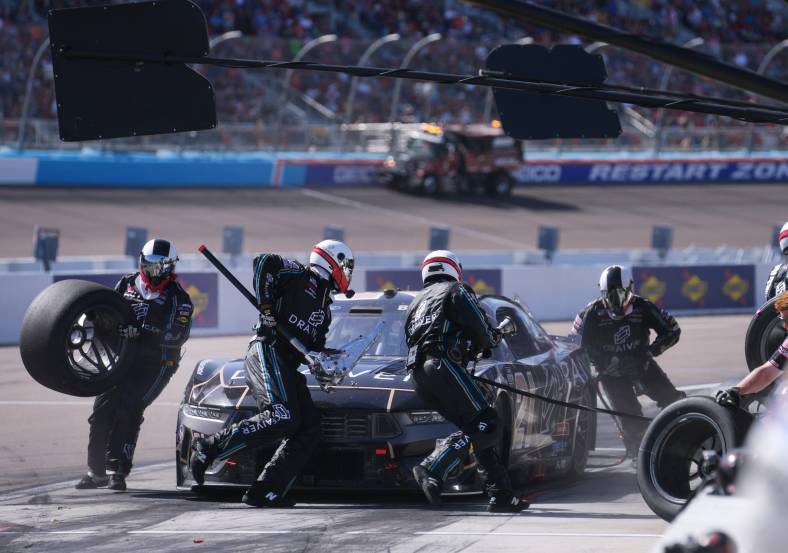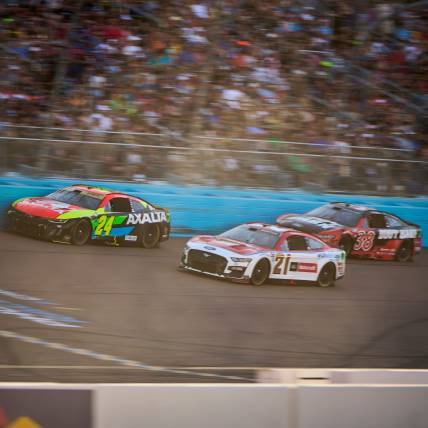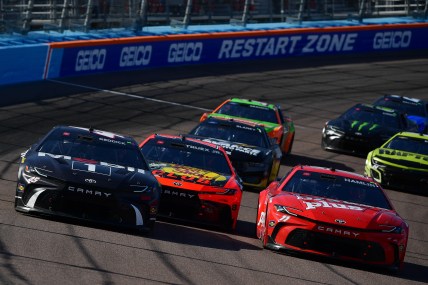
A top NASCAR official offered a response to Denny Hamlin and others who have called for horsepower increases or a clear answer over why it hasn’t been attempted and the rhetoric was a familiar refrain — cost and the potential of new manufacturers.
Brad Moran, managing director of the Cup Series, joined SiriusXM NASCAR Radio on Tuesday and fielded that question from hosts Pete Pistone and Mike Bagley.
“It’s been talked about, you know, more horsepower (and) smaller tires (which) equates to the same results, but in changing the (tapered spacer) and increasing the horsepower is relatively easy to do but we have to have all three manufacturer, obviously, on board,” Moran said.
“As soon as you do that, there is going to be reliability issues and that puts cost back into the engine and engine builder’s category, which they certainly will develop and start developing the engine.”
That’s an argument that Hamlin, who co-owns 23XI Racing and has raced at the Cup Series level for almost two decades, has also rebuffed from his standpoint.
Hamlin says the engine cost has remained the same through the un-tapered, 550 package, 750 package and 670 package eras over the past decade.
“The engine bills are the same, I’ve been saying this forever,” Hamlin said on his podcast. “The engine bills are the same now as they were when they were 900. We buy engines, we know.”
Earnhardt Childress Racing Engines SVP Bob Fisher said in December that a marginal increase wouldn’t change anything from a reliability standpoint either.
“We want all the horsepower we can get,” Fisher said. “These engines are capable of producing well over 900 horsepower. To help the racing, if they wanted us to bump up the power levels to say 750 horsepower wouldn’t be a huge tear up for the engine companies. We already have a package where we used to run engines, multiple races with the seals on, and would feel quite comfortable doing that.
“I know NASCAR, uh, they don’t really want to talk about it. They haven’t asked much of the engine companies. When they have asked, we haven’t been against it by any stretch of the imagination. I will say, I think we could give these drivers more horsepower with an engine package that has already been validated to run more than one race at a 750-horsepower level.”
Moran also says they are hesitant to increase horsepower because it could affect conversations they are having with additional manufacturers to join Chevrolet, Ford and Toyota in the sport.
“The number we’re at seems to be where we want to be to try to get potentially new manufacturers interested,” Moran said. “If we start getting away from that number, it can create problems in that area. But we’re always open to everything. We do consider everything and the engine gets talked about quite often, but there’s a lot of different parties that have to agree before that one could happen.”
As far as the new short track package goes, the one with a 3” spoiler and simplified diffuser, NASCAR expected a marginal increase in reducing dirty air and opening up passing potential and generally met those targets on Sunday at Phoenix.
“Well, I think we expected some incremental improvements and I do think we saw that,” Moran said. “Obviously there were a lot of passes during the race as far as from a data standpoint.”
Sunday’s race had 2,813 green flag passes – the highest total of any NextGen race at Phoenix Raceway:
Mar 2024 – 2,813
Nov 2023 – 2,201
Mar 2023 – 2,584
Nov 2022 – 2,065
Mar 2022 – 2,058
There were also 19 green flag passes.
“The way these races play out, you never know what you’re going get,” Moran said. “But I think we had, and again, it’s still early on, we’re going to dig into everything and talk to all the drivers and teams and do quite a bit of digging here in our R&D Center.
“We had like 2,800 green flag passes, the most with the NextGen car at Phoenix, so it did deliver that. But we’re never done looking at improvements and adjustments. Christopher Bell didn’t really seem to have too much of a problem passing, that’s for sure.
“Toyota had a dominant race and it was a pretty interesting race from the tower.”
Matt Weaver is a Motorsports Insider for Sportsnaut. Follow him on Twitter.

